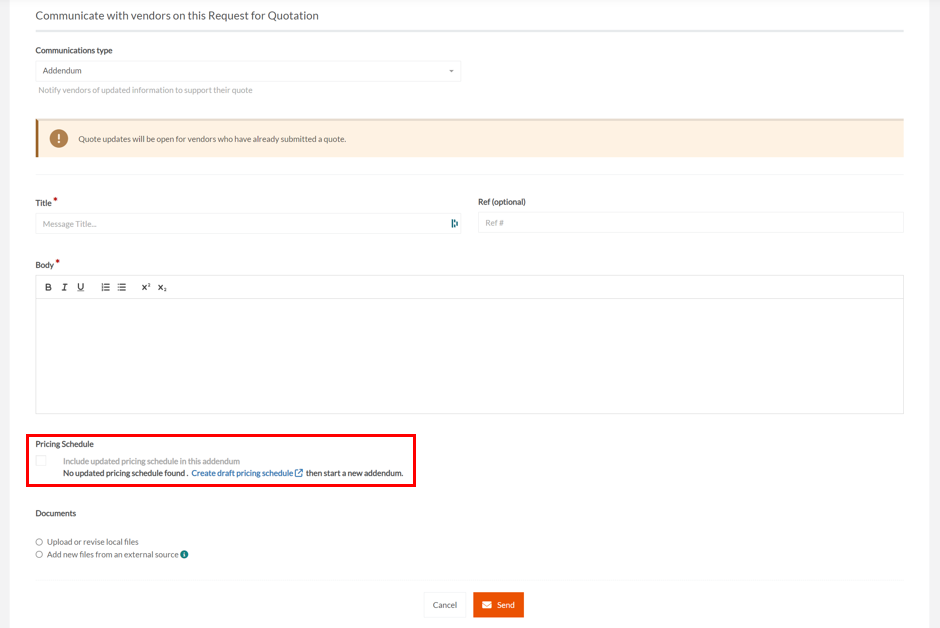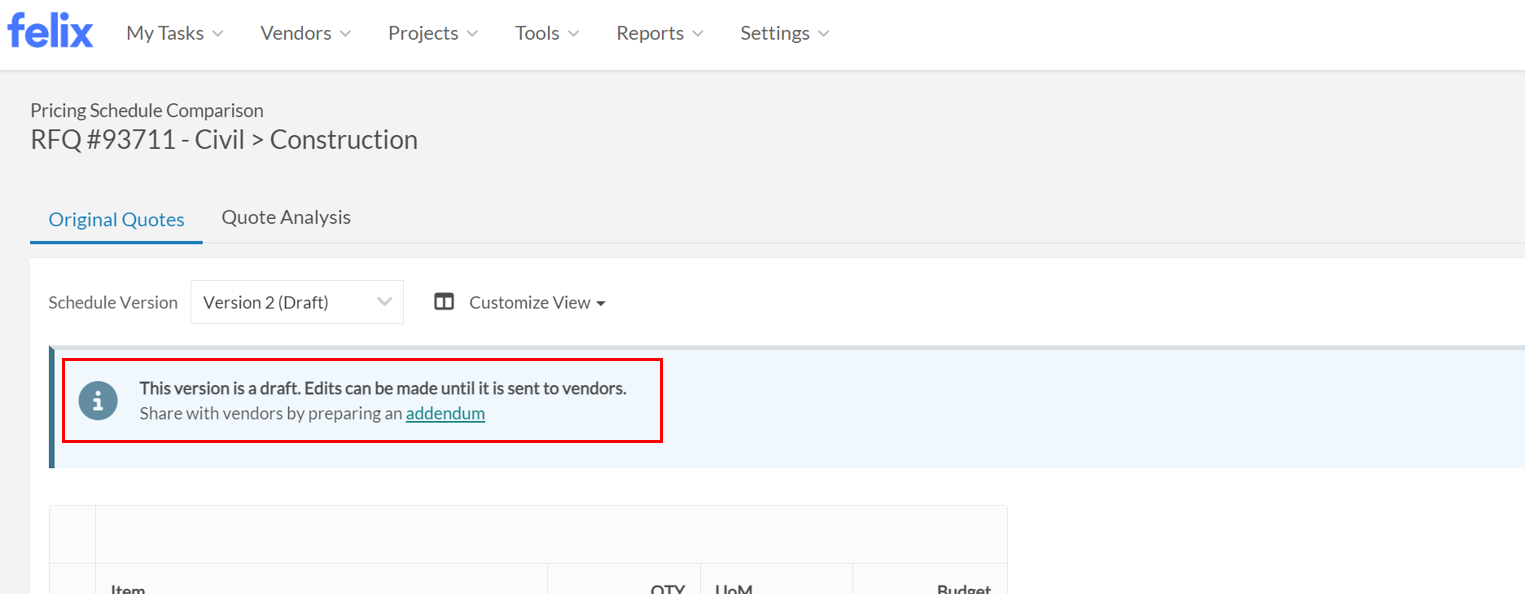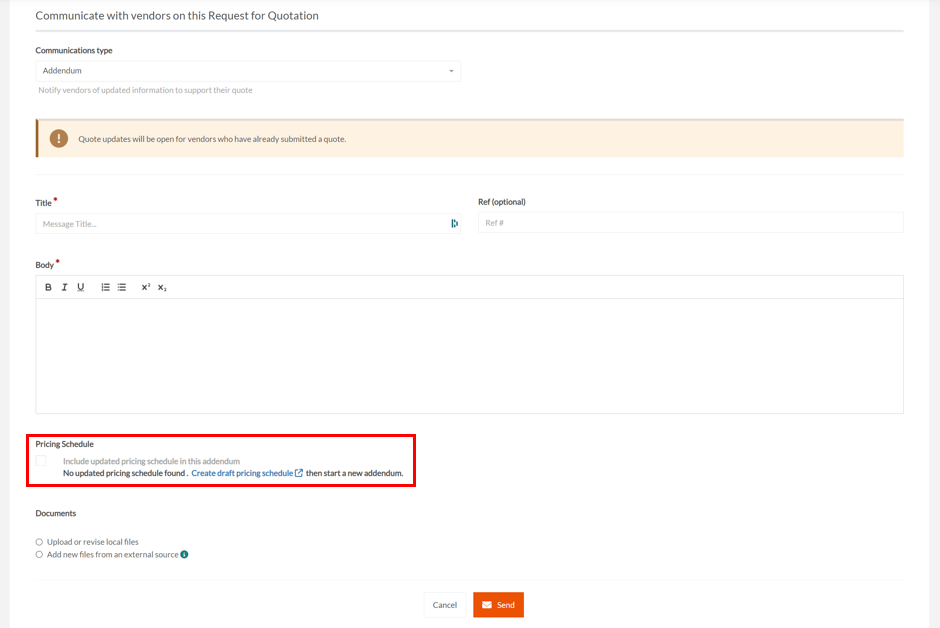Pricing Schedules are only configured to be available for some services in RFQs, per your Organisation's settings. See this article for more details.
After a pricing schedule has been created and issued on an RFQ, there are often changes throughout the RFQ period that require changes to the pricing schedule to be made.
In Felix, there are two kinds of changes that can be made:
- Internal fields - Budget and Custom ID - can be updated without the need to inform vendors.
- Revisions of a schedule can be drafted and then issued to vendors as an Addendum, or in a post tender request.
TABLE OF CONTENTS
Updating internal use only fields
If you have previously commenced a Draft version (e.g. editing fields like quantity or UoM), then the page may have a title "... - draft".
In this case, the internal use fields that you edit will apply to this version forward. Previous versions will maintain their budgets and Custom IDs.
If you wish to edit the custom ID or budget fields for the previous version, you can delete the draft, make those internal field changes and then re-start your draft to edit fields like Quantity and UoM etc.
To update these fields:
- Open the RFQ you would like to update the pricing schedule on
- Go to the Vendors tab
- Click on the Pricing Schedule Comparison button for the service you are interested in (some RFQs have multiple services). A new tab will open in your browser.
- The page will load with the latest issued version of the schedule displayed.
- Click on the Edit button (top right of page). The page will enter Edit mode.
- You can edit the Budget, Budget rate and Custom ID fields of any line item (row).
- Once you click Save, these fields' values will be present on the current version for this RFQ Item.

Drafting a new pricing schedule version in preparation to issue to vendors
You can edit all fields, all Sections, all Rows, and all column settings of a pricing schedule. With the exception of Budget, Budget rate, and Custom ID, any changes to a schedule will trigger a Draft version.
For completeness, the following changes will trigger a Draft:
- Adding a row
- Deleting a row
- Changing a row's title, UoM, quantity, reference number
- Toggling a row's Optional / Required field
- Converting a row to a Notes Row
- Adding or removing columns from a schedule (Reference number, Lead Time, Manufacturer, Suggested Quantity)
- Adding a Section
- Deleting a Section
- Renaming a Section
- Toggling a Section's Optional / Required field
To create a draft:

- Open the RFQ you would like to update the pricing schedule on
- Go to the Vendors tab
- Click on the Pricing Schedule Comparison button for the service you are interested in (some RFQs have multiple services). A new tab will open in your browser.
- The page will load with the latest issued version displayed.
- Click on the Edit button (top right of page). The page will enter Edit mode.
- Made your desired changes to the schedule.
- When you click Save, or Save & Close, you will note that the page title changes to include "draft"
Your draft is now ready and will be available in the Addendum section (Open RFQ phase), or the post tender request section (Closed RFQs) of the communications tab of the RFQ when you would like to issue to vendors.
There is also a prompt and shortcut from the addendum form to create a draft pricing schedule if there isn't already one you've created. You can use this shortcut, create a draft and then return to the addendum form to issue it to vendors later.

Issuing a draft (new version) pricing schedule to vendors
Once you have prepared a new version of a schedule in Draft, it can be attached to an Addendum (Open RFQ) or post tender request (Closed RFQ) and issued to vendors. There are two (2) routes to do this:
- From the pricing schedule comparison screen, with the draft schedule selected. You will find a text link that will open an addendum or post tender request for you and pre-select the draft schedule for inclusion in the communication.
- From the Addendum form or post tender request form, where you will be presented with drafted schedules to check to include in a communication (along with a message and documents).

Image: the shortcut available to you from a draft pricing schedule to create an Addendum (or post tender request, for a closed RFQ)
Both routes lead you to the communication form. Follow the steps below to issue a draft (new version) of pricing schedule to vendors:
Addendums:
- Note the warning alert informing you that all vendors who have quoted will have their response tab opened for edits as a result of the addendum.
- Add a title, reference (optional) and message body.
- Check the checkbox beside any available draft pricing schedules to include them in the addendum. There will be multiple checkboxes in the case of an RFQ with multiple services included.
- (optional) If you would like to also include new or revised documents in the addendum, select from the options and follow instructions to include these documents.
- Click the Send button.

You have now sent an addendum with a pricing schedule attached. Please note:
- All vendors who have not Declined the RFQ will receive an email notification of the Addendum. Vendors will be notified based on the services they have matched with - for multi-service RFQs.
- All vendors, regardless of quote status will be able to view addendums in their view of the RFQ.
- Vendors will now only be able to edit and submit the latest version of the pricing schedule. They will see their progress in completing the older version(s), but cannot edit these older versions.
Post tender requests:
- Note the warning alert informing you that all vendors who have pending post tender requests will have their previous Post tender request closed for responses.
- Add a title and message body.
- Check the checkbox beside any available draft pricing schedules to include them in the post tender request.
- (optional) If you would like to also include new documents in the communication, use the drop zone to include these documents.
- As opposed to Addendum, only vendors that you have selected for this post tender request will receive the new version of the Pricing Schedule.
- Click the Send button.
Documents included in a post tender request are not added to the Documents tab the RFQ, they are only sent to the vendors selected in the post tender request form.

Editing on closed RFQs
Once you have closed an RFQ, Addendums are no longer available to send to vendors. Post tender requests are now available in the closed RFQ phase.
You can however continue to create draft schedules or continue to edit an existing draft you may have started before the closing of the RFQ, for use on a planned Post tender request
There is also facility to edit internal fields like Custom ID and Budget or Budget Rate where you'd like to maintain accurate Custom ID records for the last released version to vendors.
- If you closed the RFQ without a draft in progress, then - as usual - you can edit the Custom ID, Budget and Budget Rate fields and Save. These values will be reflected in the Felix API for API users.
- If you closed the RFQ with a draft in progress, and you would like to edit the Custom ID, Budget and Budget Rate fields for the last version released to vendors, you are able to delete the draft. You can then edit and save these internal fields as usual.





